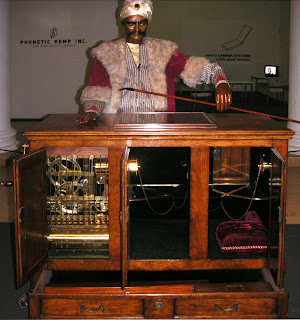I was scanning through our reference books the other day when I ran across a book called The Encyclopedia of Toys by Constance Eileen King. This book was a true delight to look through as it spanned 18th, 19th, and early 20th century toys in the United States and abroad. One particular chapter that caught my eye was a chapter on automata. A very popular, award-winning work of fiction (and subsequent movie) that gave readers a fantastical glimpse into the mystery of one particular automaton was The Invention of Hugo Cabret by Brian Selznick. Here are a few fun facts about automata:
v The New Oxford American Dictionary defines an automaton as “a moving mechanical device made in imitation of a human being” (110).
v Automatons were particularly made for adult enjoyment because the lavish backgrounds, costumes, and construction made them quite expensive. They served as status symbols in the homes of those who could afford them. They were mostly used to amuse friends and visitors.
v Automatons that were simply made, or had one or two movements were usually for children.
v The most popular subjects for automata were animals (monkeys in particular), magicians, and illusionists.
 |
| Digesting Duck - Jacques de Vaucanson |
v Vaucanson, described as the greatest maker of automata, created an artificial duck made of gilded copper and realistically feathered. His creation mimicked a live duck by eating food, digesting it, and expelling the “excrement” from its body. “The duck was still exhibited as late as 1847, when a reporter complained that the smell given by the figure was almost unbearable” (92).
 |
| The Musician - Pierre Jaquet Droz (King 94) |
v Pierre Jaquet Droz, who was an inspiration to Vaucanson, created a sophisticated automaton known as the Musician. The Musician was a young woman seated in front of a clavecin. Her fingers, head, and eyes moved as she played, and her bosom would rise and fall to simulate breathing. This automaton was first shown to the public in 1774.
v Some automatons were made to be a part of a group, such as a musical ensemble. One in particular involved a group of monkeys sitting around a card table. “One holds a cigar that is lifted to his mouth while another holds a box containing dice which it throws on to the table” (95).
 |
| Reconstruction of the Mechanical Turk |
 |
| The Draughstman, The Musician, The Writer |
v Two well-known automatons were created by Pierre Jaquet Droz, and his son Henri Louis Droz. Pierre Jacquet Droz created The Writer, an automaton that inscribed phrases on a piece of paper. It would dip its quill in ink, shake it twice, and begin writing starting at the top of the page while lifting the quill between words. Henri Louis Droz created The Draughtsman, an automaton that could draw four different images.
Check out The Franklin Institute for information on the Maillardet Automaton that inspired Brian Selznick’s book!
Image of The Writer, The Draughtsman, and The Musician together:
King, Constance Eileen. The Encyclopedia of Toys. New York: Crown Publishers, Inc., 1978. Print.
Stevenson, Angus, and Christine A. Lindberg, eds. The New Oxford American Dictionary. 3rd ed. New York: Oxford University Press, 2010. Print.
Vitaliev, V. "Spontaneous Toys." Engineering & Technology (17509637) 4.15 (2009): 86-87. Academic Search Premier. Web. 31 Oct. 2012.

No comments:
Post a Comment